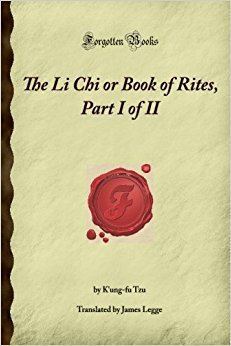Traditional Chinese 禮記 Literal meaning Record of Rites Wade–Giles Li-chi | Simplified Chinese 礼记 Hanyu Pinyin Yale Romanization Láih-gei | |
 | ||
Similar Works by Confucius, Other books | ||
The Book of Rites or Liji, literally the Record of Rites, is a collection of texts describing the social forms, administration, and ceremonial rites of the Zhou dynasty as they were understood in the Warring States and the early Han periods. The Book of Rites, along with the Rites of Zhou (Zhouli) and the Book of Etiquette and Rites (Yili), which are together known as the "Three Li (San li)," constitute the ritual (li) section of the Five Classics which lay at the core of the traditional Confucian canon (Each of the "five" classics is a group of works rather than a single text). As a core text of the Confucian canon, it is also known as the Classic of Rites (Lijing), which some scholars believe was the original title before it was changed by Dai Sheng.
Contents
History
The Book of Rites is a diverse collection of texts of varied but uncertain origin and date, lacking the overall structure found in the other "rites" texts (the Rites of Zhou and the Etiquette and Ceremonial). Some sections consist of definitions of ritual terms, particularly those found in the Etiquette and Ceremonial, while others contain details of the life and teachings of Confucius. Parts of the text have been traced to such pre-Han works as the Xunzi and Lüshi Chunqiu, while others are believed to date from the Former Han period.
During the reign of Qin Shihuang, many of the Confucian classics were destroyed during the 213 BC "Burning of the Books." Fortunately for the preservation of this work, the Qin dynasty collapsed within the decade: Confucian scholars who had memorized the classics or hid written copies recompiled them in the early Han dynasty. The Book of Rites was said to have been fully reconstructed, but the Classic of Music could not be recompiled and fragments principally survive in the "Record of Music" (Yueji) chapter of the Book of Rites.
Since then, other scholars have attempted to redact these first drafts. According to the Book of Sui, Dai De reworked the text in the 1st century BC, reducing the original 214 books to 85, and his nephew Dai Sheng reduced this to 46 books. To this three were added towards the end of the Han dynasty, bringing the total to 49.
In 1993, a copy of the "Black Robes" chapter was found in Tomb 1 of the Guodian Tombs in Jingmen, Hubei. Since the tomb was sealed around 300 BCE, the find reactivated academic arguments about the possible dating of the other Liji chapters by the Warring States period.
Li
Confucius described Li as all traditional forms that provided a standard of conduct. Li literally means "rites" but it can also be used to refer to "ceremonial" or "rules of conduct". The term has come to generally be associated with "good form", "decorum" or "politeness". Confucius felt that li should emphasize the spirit of piety and respect for others through rules of conduct and ceremonies. As outlined in the Book of Rites, li is meant to restore the significance of traditional forms by looking at the simplicity of the past. Confucius insisted that a standard of conduct that focused on traditional forms would be a way to ease the turmoil of collapsing Zhou state. The absolute power of li is displayed in the Book of Rites: "Of all things to which the people owe their lives the rites are the most important..." The ideas of li were thought to become closely associated with human nature, ethics, and social order as the population integrated li into their lives. Li is beneficial to society because it guides people to recognize and fulfill their responsibilities toward others.
Legacy
As a result of the Book of Rites' chapters, using a syncretic system and combining Daoist and Mohist beliefs, later scholars formed both the Great Learning and the Doctrine of the Mean. These two books were both believed to be written by two of Confucius' disciples one specifically being his grandson. The great Neo-Confucian Zhu Xi and his edited versions of the Great Learning and the Doctrine of the Mean influenced the Chinese society to place much more attention on these and two other books creating the Four Books. Following the decision of the Yuan dynasty (followed by the Ming and Qing) to make the Five Classics and the Four Books the orthodox texts of the Confucian traditions, they were the standard textbooks for the state civil examination, from 1313 to 1905, which every educated person had to study intensively. Consequently, the Book of Rites and two of its by-products were large integral parts of the Chinese beliefs and industry for many centuries.
